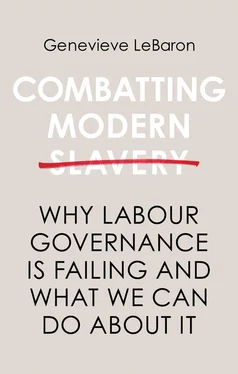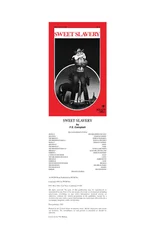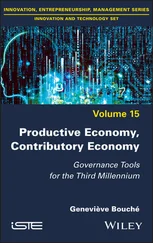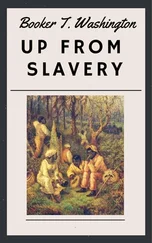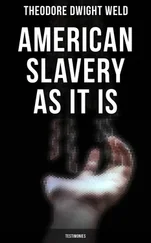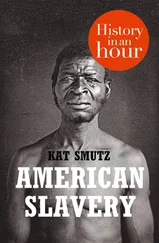Corporations have positioned themselves as champions of labour governance for a number of complex reasons, and their motivations vary across company type, scale, size and sector. Overall, though, it’s clear that big business has forged a model in which they can have strategic control over the design and implementation of labour governance initiatives. As one company CSR executive described of Walmart’s CSR efforts:
By adopting the process that said, ‘We got it, this is our ball, we’re going to do something about supply chains’ … Walmart, on behalf of the entire retail industry said, ‘This is our problem. This isn’t a government regulatory problem. This isn’t China’s problem, this isn’t Vietnam’s problem. This is our problem. We have the power, resources, and ability to deal with it and we will.’ 58
At the same time as companies have increasingly claimed that the ball of labour governance is in their court, states have stopped or struggled to enforce the labour laws on their books. Indeed, the rise of corporate auditing and CSR has coincided with the decline of state-based labour law enforcement and inspections in many jurisdictions. In countries across the global North and South, state-based labour law enforcement is now low to nonexistent. In the US, for instance, employers are very unlikely to be inspected by the Department of Labor. Economist Gordon Lafer has estimated that ‘an employer would have to operate for 1,000 years to have even a 1 percent chance of being audited by Department of Labor inspectors’. 59As labour abuse has continually been framed as something perpetrated by ‘bad apple’ and ‘rogue’ employers and criminal actors within the private economy, states have increasingly sat at the sidelines, except where they are afforded opportunities to rush in and lock up the really bad guys, heroically liberating victims of human trafficking and modern slavery.
But just because corporations have built labour governance initiatives and are pouring loads of money into them – money which, incidentally, is not being paid in taxes to government or as wages to the workers earning well below the poverty line in global supply chains – does not mean that these governance initiatives are designed or implemented in ways that meaningfully protect workers. By contrast, as I will discuss in Chapter 2, a growing body of research suggests that industry-led labour governance initiatives are failing to meet their stated aims and are doing little to solve workers’ most pressing challenges; they rarely achieve their aspirational goals of creating supply chains characterized by safe workplaces free from forced labour or predatory recruitment fees and characterized by women’s empowerment. When the design and implementation of industry-led labour governance initiatives is examined and compared against patterns of labour exploitation in global supply chains, it is unsurprising that many fail to yield concrete improvements. After all, business initiatives rarely tackle the root causes that give rise to exploitation in supply chains, and tend to structure systems to skirt around and cover up – rather than shed light into – the worst abuses.
How could there be such dire problems when rich and powerful companies are channelling their resources into addressing labour abuse through CSR, supplier codes of conduct, social auditing and ethical certification schemes, and many consumers are paying more to buy products advertised as ethically made? To understand how things have gone so badly wrong in global supply chains, we need to take a step back and look at the bigger picture of labour exploitation and deficiencies in labour governance.
In this book, I analyse four core challenges in contemporary labour governance. I argue that, first, there is a mismatch between the patterns of labour exploitation in global supply chains and the design of labour governance initiatives and their enforcement. Second, changing patterns of corporate ownership, organization and scale – and industry actors’ growing political power – is making them more and more ungovernable. Third, a sizable governance gap surrounds the booming recruitment industry, through which workers are supplied into global supply chains. Finally, a profitable enforcement industry has arisen, with vested financial interest in monitoring tools and programmes, and no financial interest in actually solving problems. These are profitable and advantageous for industry actors, but seldom lead to accurate depictions of labour standards or concrete improvements for workers.
In the remainder of this section, I’ll briefly outline each of these four challenges, which are taken up, respectively, in Chapters 2– 5, and then highlight the book’s key conclusions, which are developed in Chapter 6.
Labour exploitation in global supply chains
Labour exploitation is endemic in several industries and global supply chains today, including more minor forms like wage theft and forced overtime, as well as the worst forms of labour exploitation typically described as forced labour, human trafficking and modern slavery. The worst forms of exploitation tend to thrive more in some portions of supply chains than in others, and among certain types of businesses. 60Further, there are predictable and stable patterns regarding the workers who become vulnerable to it.
As I substantiate in Chapter 2, labour exploitation does not occur randomly or spontaneously in global supply chains. Rather, it is a logical outcome of the ways that contemporary supply chains are set up, and, more broadly, of the high-volume, low-cost business model of retail production that powers the global economy. It can be linked to political economic drivers. These include both the factors that trigger a business demand for forced labour, as well as those that create a supply of workers who become vulnerable to it.
On the demand side, a variety of pressures that lie at the heart of global supply chains as they are currently constituted create a demand among businesses for exploited labour. These include irresponsible sourcing practices, which put severe cost and time pressures on suppliers, leading to steep financial penalties for delayed orders and missed deadlines. This can lead to risky practices like unauthorized subcontracting, and to outsourcing along both product and labour supply chains, which makes oversight over labour standards difficult, in part because it fragments responsibility for workers across multiple businesses and agents. 61As the architects of global supply chains, MNCs bear sizable responsibility for business pressures experienced by suppliers, and the forms of exploitation that result from them. If they were serious about tackling labour exploitation, rather than setting up elaborate CSR programmes, corporations would alter their business practices.
On the supply side, across recent decades, political economy dynamics have created a supply of workers who are vulnerable to forced labour and overlapping forms of exploitation. These include: poverty, including among workers in lucrative supply chains; discrimination on the basis of social identity, such as race, gender and sexuality; lack of labour protections, which means that many workers face barriers to collective action and the exertion of their rights; and restrictive mobility regimes, which leave migrant workers unprotected. These dynamics have intensified in the latest era of global capitalism, as political elites and business actors have transformed the rules of the global economy in ways that privilege the profitability of businesses.
Understanding the complex political economy dynamics that give rise to labour exploitation in global supply chains is vital if we are to grasp the weaknesses within prevailing initiatives to tackle it. In particular, it is essential to understand the disjuncture between the patterns of labour exploitation and the design and enforcement patterns of industry-led initiatives, which tend to circumvent the portions of supply chains in which exploitation is known to manifest and thrive.
Читать дальше
